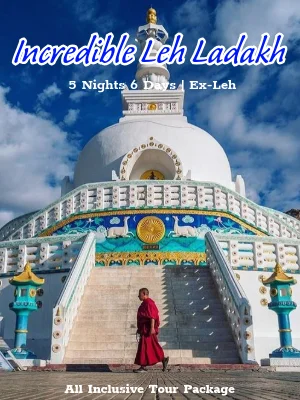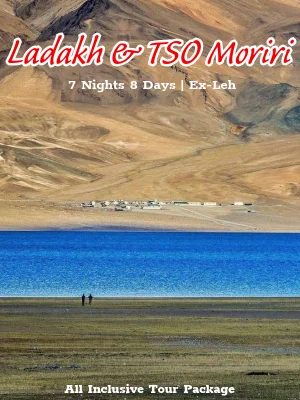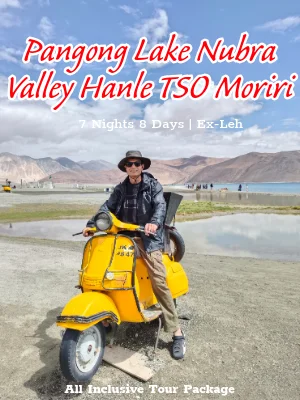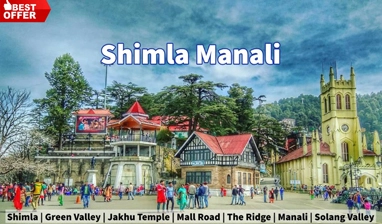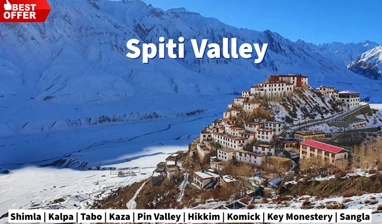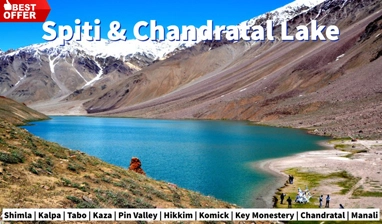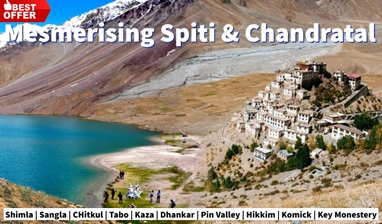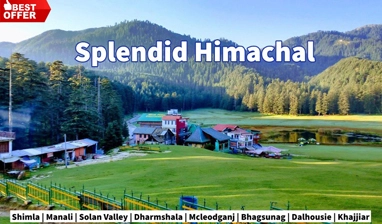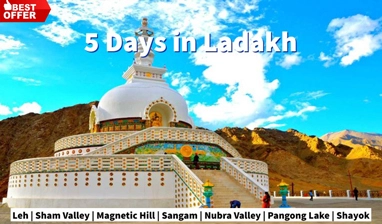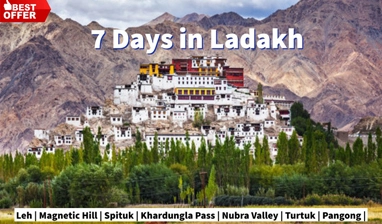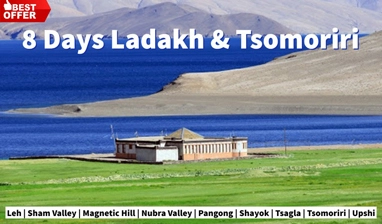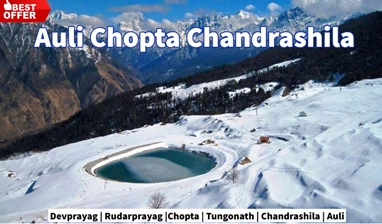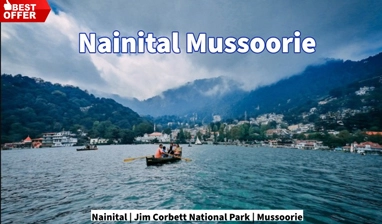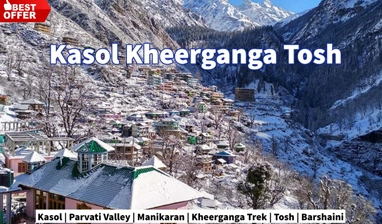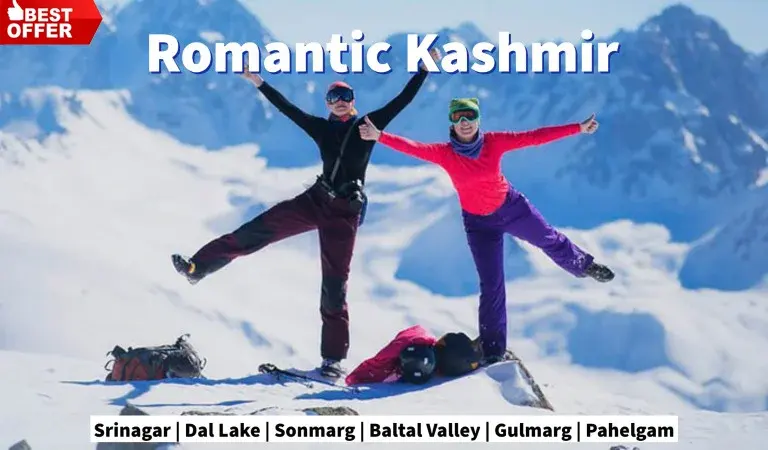Ladakh The only explanation about the beauty of Ladakh is that if you cannot go to moon, just go there. Beyond this the words end.
Commonly described as Crown of India, Ladakh is the land of high passes, salt lakes, large glaciers, richest Buddhist Monasteries and its moonlike landscape. The beauty remains scattered here and there. Entirely different form the other parts of India, Ladakh holds a precious status for a tourist as the access to the region is not easy. You may fly into Ladakh but the chances of Mountain sickness demand at least a day to allow you to get acclimatised. To avoid that follow the best way, if time permits, and drive through the high passes, deep gorges, remote villages and vast plateaus that served as lakes once upon a time.
Ladakh is a home of challenges and both, the drive and the beauty, are breath taking. The geographical carvings that occur due to wind and water erosions hold a stunning attraction for the viewer. The high altitude lakes, mainly glacier fed, are the main sources of various streams and the rivers are some of the jewels of this Crown of India.
Ladakh is also the land of Buddhism. Nearly one thousand years ago Renchen Zongpa, a teacher from Tibet had set up the Buddhist education centres across Indian western Himalayas. Some of them like Hemis, Likir, Lamayuru, Alchi, Stakna and Dishkit are still there, serving are one of the biggest Tibetan education centres.
Ladakh shares is borders with China and Pakistan, therefore remains under the threat from these two countries. Siachien glacier – the highest battle field in the world is to its western tip. A visit to the base of Siachein can be the highlight of the trip.
Ladakh remains open only for a few months of the year from June till September and this is the best time to visit and explore the region.

The Shanti Stupa in Leh is a magnificent white-domed Buddhist monument located atop a steep hilltop at a dizzying height of 11,841 feet. It is a religious place for the Buddhists as it holds the relics of Buddha, consecrated by the 14th Dalai Lama. It is also popular amongst tourists as it offers a sweeping view of Leh and the nearby Changspa village. Shanti Stupa looks exceptionally beautiful during the full moon night when it is naturally illuminated by the moonlight. Shanti Stupa was constructed in 1991 by Japanese Buddhist, Bhikshu Gyomyo Nakamura. The construction was jointly done by the Japanese and Ladakhi Buddhists to mark the completion of 2500 years of Buddhism and to promote world peace. It is a part of the peace pagoda mission, which aims to spread peace through the preaching of Buddha. Shanti Stupa is a perfect getaway for both- those looking to obtain peace from offering prayers to God and those waiting to be mesmerised by nature's wondrous beauty.
For more information please call us at: (+91) 78310-50555, (+91) 98163-50555

Nubra Valley is famous for the Bactrian Camel Safari. These camels are known for their two humps, rather than the one-humped camels usually seen. They were the major mode of transport to travel to silk route. These are now used for the safari in the region is hugely popular among the tourists. The best time to enjoy the Bactrian camel ride in Nubra Valley is from July to September. These Hundur camels have a capacity of carrying 2-3 people at a time.
For more information please call us at: (+91) 78310-50555, (+91) 98163-50555

Shyok Village is a hidden gem located in the Nubra Valley region, between Leh and Pangong Lake. Located on the banks of the Shyok River, this tiny hamlet is an offbeat location with only a few houses and families. It is the perfect place to slow down, breathe in nature and get away from the daily routine. Shyok village is located on one of the old caravan routes connected to the Silk Route. The entire village runs on solar energy while high electricity appliances are banned. There are man-made irrigation channels spread throughout to conserve water. Since Shyok Village sits in the lap of Kumarakom ranges, it offers breathtaking view. Must Know Before You Visit Shyok Village: - There is no wifi or phone netwrok in Shyok - Some small homestays are available for stay. - The road to Shyok village runs close to the river which sometimes run over and cause flooding. Be careful if travelling on a bike. Also, avoid travelling at night.
For more information please call us at: (+91) 78310-50555, (+91) 98163-50555

MoonLand - Lamayuru: A peculiar landscape near Lamayuru on Leh-Kargil Road is the MoonLand. It is called so fondly, because the landscapes here are said to be like that of the moon. It has also been said often, that on a full moon night, the area is an extraordinary sight to behold, something one doesn't get see everyday, making it a must visit area of the town.
For more information please call us at: (+91) 78310-50555, (+91) 98163-50555

Darcha Padum: Located on river Bhaga, Darcha is a small Lahaul region in the Himachal district of Spiti. Whereas Padum is among the two primary capital cities of the Zanskar society in Ladakh. There are plenty of camping sites en route, spread across a variety of nomadic sites travelers would pass by. The Darcha-Padum stretch is about 127 kilometres. Witnessing incredible mountain ranges, expanses of absolutely quite lands, a couple of mountain animals and small streams are some of the guarantees on the Darcha-Padum.
For more information please call us at: (+91) 78310-50555, (+91) 98163-50555

Yarab Tso Lake: The holy Yarab Tso lake, often referred to as "the hidden lake", is the best-kept secret of Ladakh. Located near the Sumur Village, approximately 15 km from Diksit in the Leh Ladakh region, this gorgeous lake can only be reached by hiking uphill for 20 minutes. Regarded as one of the holiest and high altitude lakes in the Nubra Valley, Yarab Tso is highly revered among the locals of the region. It is advised not to wash your feet or try to swim in this enrapturing lake. Simply sit by the rocks, breathing in the unpolluted mountain air, relishing the site of colourful prayer flags fluttering around the crystal clear aquamarine water and experience the sense of calmness it brings. How to Reach Yarab Tso: The Yarab Tso Lake can only be reached on foot, hiking for about 20 minutes from the Panamik Village near Sumur.
For more information please call us at: (+91) 78310-50555, (+91) 98163-50555

Pathar Sahib Gurudwara: Gurudwara Pathar Sahib is a beautiful gurudwara, dedicated to Guru Nanak Dev. It is located 25km from Leh on Leh Kargil road. The gurudwara is highly revered as it houses a rock which resembles Guru Nanak's back. It is built at the site where he is believed to have vanquished a demon. The gurudwara is looked after by the lamas and the Indian army. The locals believe that in the 15th century, Guru Nanak stayed at this location which was dominated by a demon. When the locals sought his help, the demon threw a boulder towards Guru Nanak that turned into wax on touching his back and took its shape. This rock is now worshipped at Gurudwara Pathar Sahib. Most of the vehicles stop here and pay their respects before continuing on their journey.
For more information please call us at: (+91) 78310-50555, (+91) 98163-50555

Turtuk: Turtuk is a small village located in Nubra Valley region of Ladakh, on the banks of Shyok River. It is the northernmost villages in India lying very close to the India Pakistan border, in the Baltistan region. Turtuk is an unexplored and offbeat place, opened to tourists only in 2010. There isn't much to do in Turtuk apart from trekking and visiting the 2 monasteries and the Royal House. The picturesque village with its tiny houses and fields is surreal. It remains cut off from Ladakh for 6 months during winter. The charm of Turtuk is its people and culture. It is one of the few places in India to experience the Balti culture as Turtuk is one of the four Baltistani villages under India's control. The rest are controlled by Pakistan. The postcard village houses a few homestays and guesthouses with locals welcoming tourists with warmth.
For more information please call us at: (+91) 78310-50555, (+91) 98163-50555

Druk White Lotus School: The Druk White Lotus School, also known as Druk Padma Karpo School, is a Buddhist cultural school located in the Shey valley, close to Shey Monastery and Palace. It is popular as the Rancho School from the famed Bollywood movie 3-idiots. It has become a popular tourist attraction, even though it is a not public tourist spot. The main attraction here is the Rancho Wall, which was orginally the building where "Chatur" was given the electric shock. After it was destroyed in the 2010 flash floods, a replica of this wall has been created at a corner of the school campus. A 15-minute guided tour is available of the Rancho School. There is also a Rancho's Cafe and a souvenir shop inside the school premise.
For more information please call us at: (+91) 78310-50555, (+91) 98163-50555

Chang La Pass: Chang La Pass is a high mountain pass and one of the highest motorable roads in the world. It is located between Leh and Pangong Lake and is the main gateway to the Nubra Valley region. The 15km long pass is especially popular amongst bikers. The roads are mostly paved and are driveable by any vehicle. Changla is open for tourists from Mid May to October. To avoid high altitude sickness, doctors suggest not to stay at Changa La Pass for more than 20 minutes. The Pass is guarded and protected by the Indian Army as it is located close to the Chinese border. Reverberating with serenity and tranquility, the place remains covered with snow throughout the year. The world's highest research station established by DRDO (Defence Research and Development Organisation) is located at Changla. The Chang La Temple, dedicated to Changla Baba, is also located here.
For more information please call us at: (+91) 78310-50555, (+91) 98163-50555

Shey Monastery: Shey Monastery or the Shey Palace is an ancient monastery located 15km from Leh. It once served as the summer capital of Ladakh but is mostly in ruins now. Located on top of a hillock, it offers stunning panoramic views. The highlight of the monastery is 39ft tall Shakyamuni Buddha statue which is the second largest Buddha statue in Jammu & Kashmir. A special permission needs to be taken to visit the monastery. Shey Monastery is often visited along with the surrounding Thiksey Monastery, Hemis Monastery, Stakna Monastery, and Matho Monastery. The monastery complex is adorned with various murals and rock carvings of Buddha. 400 metre away is anothe rshrine which houses the Shakyamuni Statue in the sitting posture. The best time to visit the monastery is during Shey Rhupla and Shey Doo Lhoo festival celebrated in July or August. The Shey Palace was built in 1655 by Deldan Namgyal, the king of Ladakh, in memory of his father.
For more information please call us at: (+91) 78310-50555, (+91) 98163-50555

Hunder Village: Hunder is a remote village located in the Nubra Valley region, 7km from Diksit Monastery. It is known for its sand dunes, cold desert and bactrian camel rides. It is also home to forests of sea-buckthorn, which is a medicinal plant. Hunder is popular amongst trekkers. Tented accommodations by private operators are available here. Hunder village has a vast expanse of green and breathtaking beauty. The Hunder Gompa located here is one of the oldest monasteries in Nubra Valley. The village is located close to Siachen Glacier the Pakistan border, and the area beyond is under the control of the army. Indian visitors do not need an inner line permit to visit Hunder Valley. Hunder's claim to fame is the Bollywood song of the movie "Dil Se", starring Shahrukh Khan and Manisha Koirala, shot here.
For more information please call us at: (+91) 78310-50555, (+91) 98163-50555

Alchi is a beautiful tiny hamlet, placed on low land. It lies on the banks of Indus River, at a distance of around 70 km westwards of Leh. The village is known to have fertile land. Notice the apricot trees on both the sides of the road as you explore the place. The influence of Hinduism, Buddhism as well as Islam can be seen here. Explore this wonderful place and visit its various attractions like Sumtsek Temple, Manjushree Temple, Monk Cells and so on. Do not miss a visit to the very popular Alchi Monastery, one of the most popular monasteries in Ladakh.
For more information please call us at: (+91) 78310-50555, (+91) 98163-50555

Nyoma Village: Nyoma is a quaint village located 150 km from Leh on the banks of the Indus River. The main attraction of this unexplored village is a Buddhist monastery and the long walks in the peaceful lanes. Nyoma is best visited as a stopover when travelling to Chumathang from Leh. An inner line permit is required to visit Nyoma and its monastery.
For more information please call us at: (+91) 78310-50555, (+91) 98163-50555

Sindhu Darshan Festival: The Sindhu Darshan festival is celebrated along the banks of the river Sindhu in Leh Ladakh region, every year on the full moon day. Celebrated over three days, this is a celebration of River Sindhu, the former Indus Valley Civilisation, with the motive of endorsing the river as an icon of communal harmony in India. The Bollywood movie "Dil Se" was shot at the first Sindhu Darshan Festival.
For more information please call us at: (+91) 78310-50555, (+91) 98163-50555

Zanskar Valley: Located in the Kargil district to the east of Ladakh (around 105 km) lies the bewitching Zanskar Valley. Pronounced as Zahar or Zangskar locally, it is separated from Ladakh by Zanskar mountain range which is a part of The Tethys Himalayas. Zanskar is known for raw landscape and is mostly travelled to for trekking and river rafting. The semi-desert region is flanked by snow-capped mountains and sparkling clean rivers along with distinct flora and fauna. The easiest way of reaching Zanskar is from Kargil through Suru Valley. It is cut off from the rest of the world for over 9 months of the year because of heavy snowfall in the region. The only way of reaching Zanskar during the winter months of December to February is undertaking the challenging Chadar Trek.
For more information please call us at: (+91) 78310-50555, (+91) 98163-50555

Magnetic Hill: The popular Magnetic Hill of Ladakh is a cyclops hill where vehicles defy the force of gravity and move upwards on the hill when parked at the marked location. To experience this phenomenon, park the car in neutral gear in the yellow box marked a few metres ahead of the Magnetic Hill road. From this point, the car starts moving at a speed of 20 kmph. The Myth behind the Mystery of Magnetic Hill: We live in a strange world where sometimes there is no logical explanation of beliefs and superstitions. People say the hill has superpowers that transport the worthy to heaven. However, there is not one but two plausible scientific explanations behind this majestic magnetic hill. The Optical Illusion Theory: The first theory states that this Magnetic hill is an optical illusion caused by the descending and rising terrain. The alignment of the road and the absence of a visible horizon creates a downward slope to appear like an upslope. The Magnetic Field Theory: The second theory states that the hill exudes a strong magnetic force that pulls vehicles parked within its range. Many tourists and Indian Air Force officials have collaborated with this theory. The hill lies at a distance of 30 km from the town of Leh on the Leh-Kargil highway, at an elevation of around 14,000 feet above sea level. It is one of the major tourist attractions and an almost essential stopover for all those who travel to Ladakh. An optical illusion or actuality, the Magnetic Hill in Ladakh has mysterious magnetic properties that draw tourists from across the globe.
For more information please call us at: (+91) 78310-50555, (+91) 98163-50555
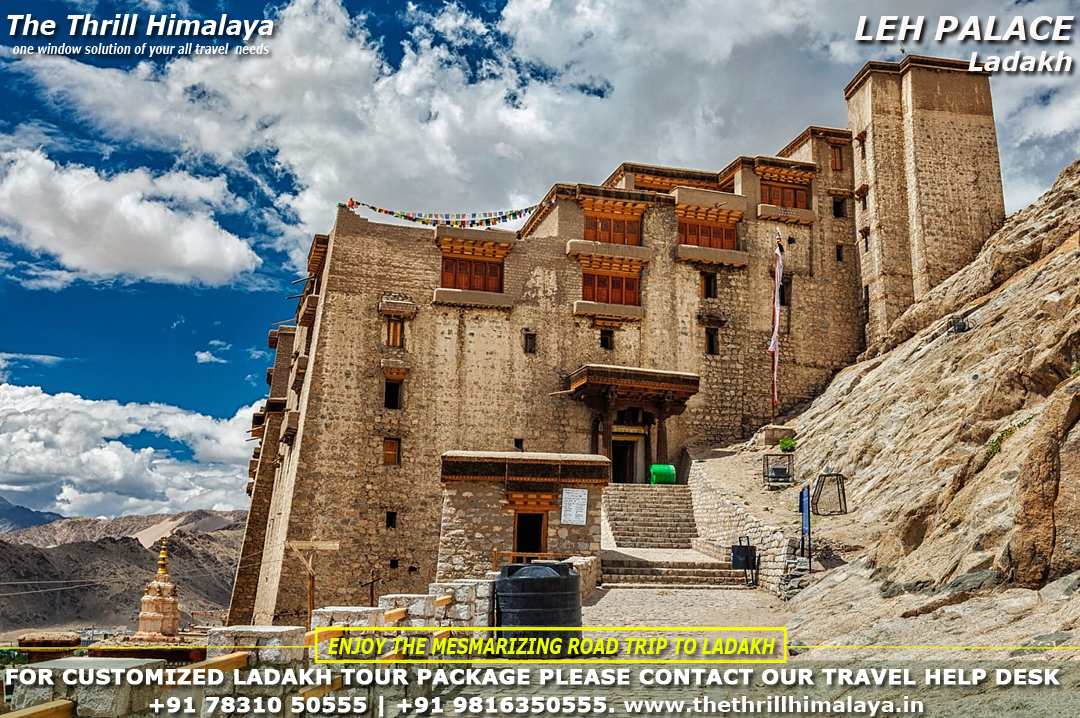
Leh Palace: The Leh Palace, also known as 'Lhachen Palkhar,' is a 17th-century former royal palace and one of the central attractions in Leh. Built under the patronage of by King Sengge Namgyal, it used to house his family. The nine-storey dun-coloured palace now houses a museum and a prayer room, while the highlight is the sweeping view of Leh and the surrounding Zanskar mountain from the rooftop. The Leh Palace is modelled on the Potala Palace in Lhasa (Tibet), and a considerable part is now in ruins due to the Kashmiri invasion that took place in the 19th century. The beauty of the Leh Palace still stands in pride with a lot of ancient Buddha relics, paintings, old utensils, cutlery used by the royal family and artefacts adorning the walls, most of which are almost 450 years old. The palace looks even more stunning when it is lighted upon certain special occasions, such as Galdam Namchot festival when locals gather around the palace to celebrate the local festival. The majestic palace is presently under the Archaeological Survey of India, which is working on renovating the ancient structures of that era and striving to keep intact the history of the Namgyal dynasty in Leh.
For more information please call us at: (+91) 78310-50555, (+91) 98163-50555

Khardung La Pass: Khardung La, also known as Khardzong La, is a high mountain pass in Ladakh region of Jammu and Kashmir, near Leh. It serves as the gateway to Shyok and Nubra Valley. Khardung La is popular as the highest motorable road in India at an elevation of 5602 metres. However, contrary to the belief, its actual elevation is 5359 metres making Dungri La the highest motorable road pass in India. Khardung La pass is a perfect getaway for adventure enthusiasts, peace seekers and mountain biking aficionados. An Inner Line Permit is required by the tourists to enter the pass and travel through it. Due to heavy rains and snowfall, the Khardung La pass remains closed from October to May. Khardung La was built in 1976 and was opened for public in 1988. The pass is very important for India as it is used to carry supplies to Siachen glacier. From the top, you can get picturesque views of the Karakoram range and the Himalayas. Khardung La Weather & Best Time to Visit: The best time to visit Khardung La pass is between April to June and September to October. During summers, you will find the route less dangerous as the roads are dry. The sun shines bright with the temperature lingering at 21 degrees Celsius. However, nights can get cold when the mercury dips down to 7 degrees Celcius. Incessant rains and heavy rainfall from July to August and from November to February make Khardung La pass inaccessible. Often, the pass is even closed down during these months. Road Condition: Road condition is good for about 25 km on your way to the Khardung La pass until South Pullu. From South Pullu to Khardung La, you will encounter bad patches and broken roads. For around 14 km, the route condition deteriorates with slush and water streams caused by melting snow.
For more information please call us at: (+91) 78310-50555, (+91) 98163-50555

Nubra Valley: Nubra Valley lies in the union territory of Jammu & Kashmir, at a distance of around 140 Km from Leh. Located on the ancient Silk Route, the valley has Shyok and Nubra river snaking through it and some beautiful monasteries. The region is currently under military supervision because the road further leads to the Siachen base camp, which happens to be the highest battlefield in the world. All foreign nationals need to get protected area permit, and Indian travellers need to obtain an Inner Line Permit to enter the Nubra valley. You need to hand over the photocopies of your travel permits to the soldiers in the Khardung La pass. Most tourists travel to Nubra Valley from Leh through Khardung La. With arid mountains in the backdrop, Nubra Velly is famous for the Bactrian camel rides. Bactrian camels are of the rarest sort, having two humps and were the primary source of transportation in the silk route. It is also famous for its Hippophae shrub, popularly known as Leh Berry. In Diksit, you can buy some lovely Kashmiri or Tibetan artefacts, Pashmina shawls, woollen socks, almonds, apricots, apples and other things that define Kashmir.
For more information please call us at: (+91) 78310-50555, (+91) 98163-50555

Tso Moriri: Tso Moriri Lake is the largest high altitude lakes in India situated at an altitude of 4,595m. Located between Ladakh and Tibet in the Changtang region, it is a twin to the Pangong Lake. This lake offers a scenic place of peace and tranquillity flanked by mountains, measuring about 28 km in length from north to south, and 8 km wide. An inner line permit is required for visiting Tso Moriri. The stunning Tso Moriri can be visited only during the summer months starting from April when the lake starts to melt. May, June, July and August are the peak tourist season. Tso Moriri remains inaccessible and entirely frozen from January to March. Tso Moriri is a declared Ramsar site which means one cannot set up a tent or construct anything near the lake. A number of birds can be spotted at Tso Moriri like the bare-headed goose, the great-crested grebe, the Brahmin duck and the brown-headed gull. Himalayan hares are abundantly found here too. It is also called the 'mountain lake', owing to the peaks that surround it, towering at a height of 2000 meters, shutting it off from the outside world.
For more information please call us at: (+91) 78310-50555, (+91) 98163-50555

Pangong Tso: The most popular tourist attraction in Ladakh, Pangong lake is an endorheic (landlocked) lake situated at 4350 meters. Also known as Pangong Tso, it is 12 kilometres long and extends from India to Tibet. Almost 60% of Pangong Lake lies in the Tibetan Autonomous Region. A unique feature of the lake is that it does not remain blue throughout the year or even the day, rather it changes colours from azure to light blue to green and grey too! It is famous amongst tourists as the spot where the Bollywood movie "3 Idiots" was shot. Since the enthralling Pangong Lake falls on the Sino-Indian Actual Line of Control, an inner line permit is required to visit it. The Indian Nationals can easily obtain individual permits while other foreign nationals need to obtain a group permit, with at least 3 persons in the group, accompanied by an accredited guide. The permit can be obtained at the tourist office in Leh, for a small fee. Owing to its altitude, the Pangong Lake temperature ranges from -5°C to 10°C as a result of which it freezes completely during winters in spite of its salinity.
For more information please call us at: (+91) 78310-50555, (+91) 98163-50555

Thiksey Monastery: Thiksey Monastery is a tibetan-style monastery located 20km south of Leh, on Leh Manali highway. The twelve-storey monastery is located on top of a hill, giving magnificent views of the town and the Indus valley below. The main highlight of Thiksey is the Maitreya Temple which houses a 15-metre high Maitreya Buddha statue. It covers two-stories of the building and is the largest such statue in Ladakh. Thiksey consists of numerous white buildings that are arranged in hierarchical order, which stand out against the rocky golden brown hills. It resembles the Potala Palace in Lhasa, Tibet. Thiksey consists of 10 temples and is currently home to over a 100 monks. The monastery houses Buddhist stupas, thangkas, swords, wall paintings and statues. Other main attractions at Thiksey are Tara Temple, Lamokhang Temple, Assemnly Hall, Nunnery, Library and the rooftop. The monastery also serves as a residential monastery for monks.
For more information please call us at: (+91) 78310-50555, (+91) 98163-50555

Hemis Monastery: Hemis Monastery is a Buddhist monastery located 45 kms south of Leh. Built by the Ladakhi king Sengge Namgyal, it is ranked as one of the wealthiest monasteries in India. Hemis Monastery is most visited during the annual Hemis Festival, held every year in early June. Hemis Monastery houses a spectacular copper statue of Lord Buddha along with stupas made of gold and silver, thangkas (a painting on cotton or silk, depicting Buddhist deity) and murals. The vast courtyard and a picturesque verandah are adorned with colourful paintings of Buddhist Kalachakra. Hemis Monastery belongs to the Red sect or Dugpa Kargyupta order of Buddhism. All four sides of the monastery are decorated with the colourful prayer flags which flutter in the breeze and sends out prayers to Lord Buddha. It is also an institution for the teaching of Tantric Vajrayana. Historical Significance: The history of Hemis Monastery goes way back to the middle ages. According to the legend, it is dated to the arrival of Naropa, a prominent Buddhist teacher, who arrived at some point in the 11th century. He was once the head of a monastery in Nalanda, from where he was forced to flee due to a sacking by an invading Muslim army. After that, he relocated to the Hemis Monastery and established the Kagyu school of Buddhism here. A written documentation by A. Grunwedel about the life of Naropa and his disciple Tilopa was later found in the neighbourhood of the monastery. It states that he met with Tilopa, Tantric scholar and assigned him the task of translating Marpa.
For more information please call us at: (+91) 78310-50555, (+91) 98163-50555
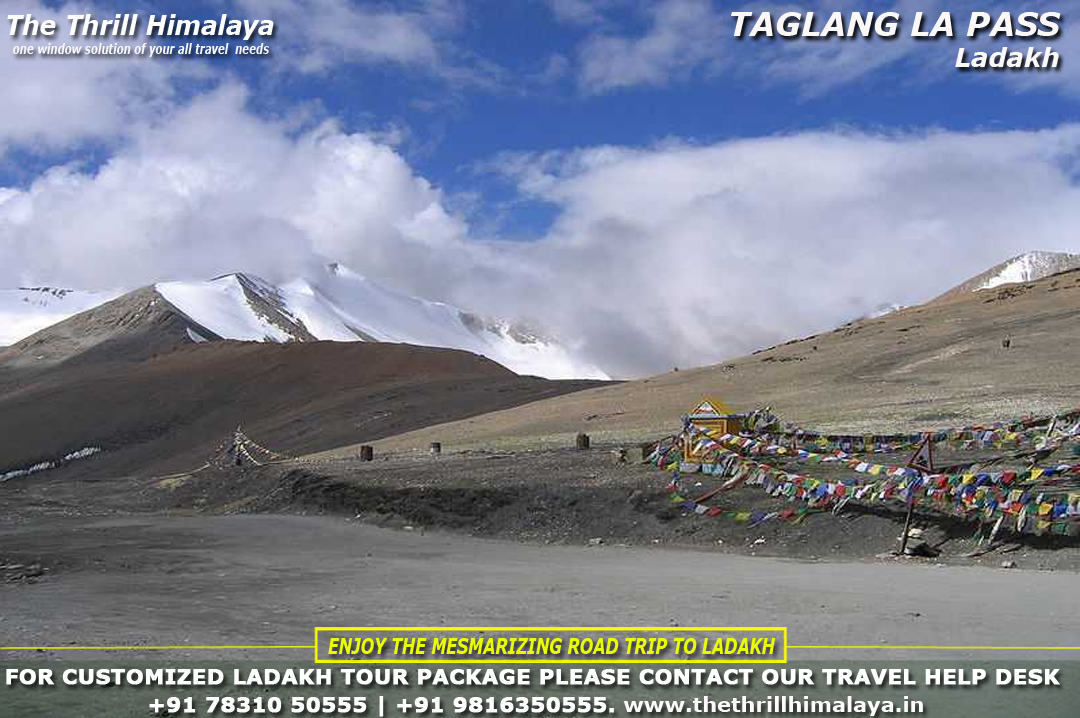
Taglang La Pass: The Tanglang La is a one of the high mountain road located on the Leh-Manali highway just a few kilometers from Leh. It is at a height of 5,358 metres, is the second-highest mountain pass after Khardung-La Pass, and is also the 12th highest motorable pass. This popular spot in Ladakh is known for being the second highest mountain located in Zanskar range. The pass summit is breathtaking and is adorned by a number of prayer flags. The Tanglang-La has in the past served as a trade route and a religious centre. Known for its amazing and dramatic landscape, the Taglang La pass provides a blissful experience in the Himalayan trails with greenery. The pass provides for an extremely thrilling adventure, but it can be nerve-wracking for first-time riders, because of its unpredictable turns and the extreme cold, which can often dip to -35 degree Celsius. At these temperatures, the supply of oxygen can get dangerously low, and riders and tourists also often fall sick while driving to this pass.
For more information please call us at: (+91) 78310-50555, (+91) 98163-50555

Chadar -The Unique Frozen River Trek: Imagine walking across frozen sheets of ice, with mountains enveloped by snow on one side and a stream, slowly freezing or melting right on the other, as you walk alongside it. And while that seems fascinating, look up, ahead and around; to witness surreal beauty for as far as you can see. This is the Chadar Trek , the Frozen River Trek, only multiplied a hundred-fold. The Chadar Trek or The Frozen River Expedition is one of the most unique and challenging treks in India. The 6 day chadar trek across the frozen Zanskar River in Ladakh takes place during the latter part of January till end of February or sometimes even in the first week of March, depending on the weather. The locals or Zanskaris as they are popularly known, usually take a road from to the Zanskar to Nerak and further for work which mostly consists of trading goods in the summers. During winters, the road is blocked and dangerous to travel so the locals tread along the Zanskar river which is frozen at this time. The thick blanket of ice that the Zanskar river forms resemblances a white blanket which in the local language is called ?Chadar?. Hence the trek along the frozen Zanskar River is known as the Chadar Trek. Though, it seems a challenging trek, it isn't the most difficult; as it basically is a flat walk along the Chadar with minimal amounts of climbing. If you can walk for a couple of hours without much strain, you are good to go.
For more information please call us at: (+91) 78310-50555, (+91) 98163-50555

Sangam: Sangam is the confluence of Indus and Zanskar Rivers in Ladakh. It is located 35km from Leh in Nimmu, on the Leh Srinagar highway. The two rivers can be separately seen meeting at this point. While the Indus River appears as shiny blue, Zanskar River appears muddy green. It is a spectacular site to witness. The flow of the two rivers at Sangam changes according to the season. While Zanskar River is swollen and rapis in summers, Indus River is calmer. In winters, Zanskar slows down and almost freezes while the flow of Indus is even lesser. The Indus is the one of the longest rivers in Asia and originates in Tibet. Zanskar River is formed in the Zanskar Valley region.
For more information please call us at: (+91) 78310-50555, (+91) 98163-50555
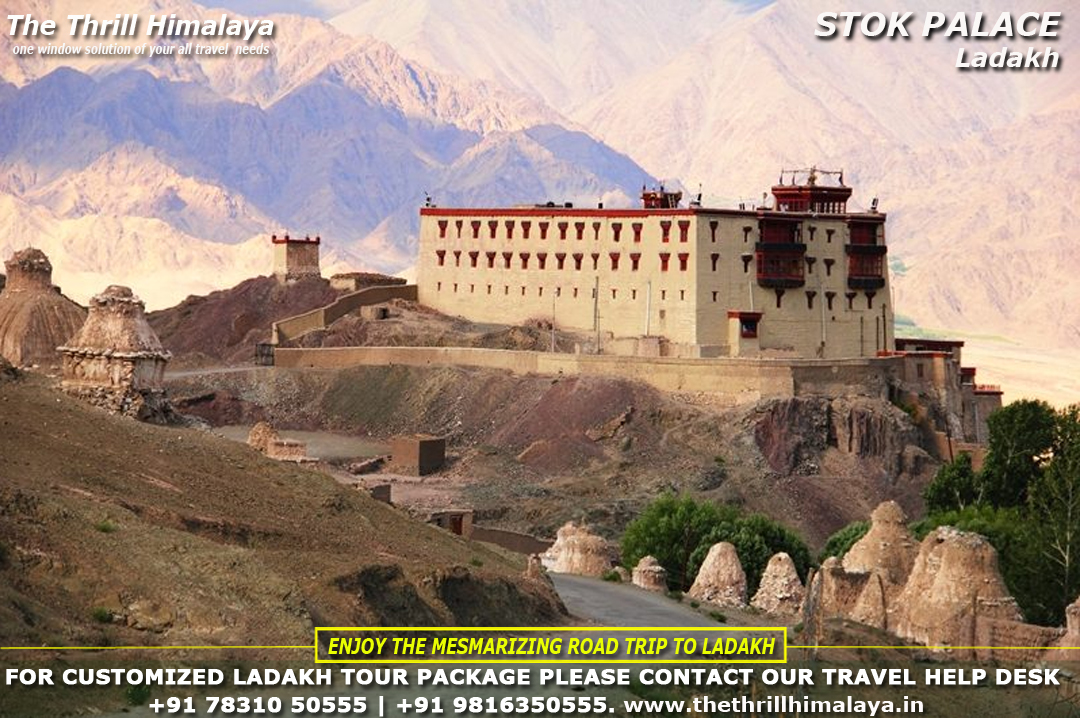
Stok Palace: Located around 15km from Leh, the Stok Palace is the summer home to the royal family of Ladakh and descendants of King Sengge Namgyal. It was established in 1820 by King Tsepal Namgyal and was opened to the public in 1980 by the Dalai Lama. The Stok Palace has been converted into a heritage hotel and houses the Stok Palace Museum and Temple. The rustic interiors of the hotel emit royal antique decor alongside some quirkily decorated rooms as well. Besides, the Stok Palace is a well-preserved traditional piece of the Buddhist culture too. The hotel is divided into six units within the Stok Palace and three more divisions in the Chulli Bagh Villa. Stok Palace Museum Inside the resplendent palace exists the Stock Palace Museum, which is home to precious artefacts and jewels of King Sengge Namgyal and his descendants which attracts a lot of historians and anthropologists. Ancient coins, royal seals, precious jewellery and photographs can be found preserved in this museum. Here one can also find the royal family’s collection of paintings of the Buddhist Deities which are over 400 years old. They are known as Thangkas and are very popular among the Buddhist community. There is also a separate room with an assortment of guns, shields, swords, quivers and arrows which belonged to the royal family. The major highlight of the Stok Palace Museum is Yub-Jhur, which is the queen’s crown having 401 lumps of ancient turquoise, coral and golden nuggets along with other ancient jewels. Another ancient artefact is the king’s sword which was bent in a knot by the king’s oracle.
For more information please call us at: (+91) 78310-50555, (+91) 98163-50555

Rafting in Ladakh: River rafting is one of the top adventure sports in Ladakh. Besides offering a unique rafting experience, the Indus waters in Ladakh also traverse through spectacular sceneries, monasteries and villages. Rafting expeditions on the Zanskar River also marvellous. Known as the Grand Canyon of India, this region holds high cliff-like gorges at certain places. With varying rafting choices depending on the season, personal physical fitness, cost and experience, Ladakh offers grade one to grade four range of rapids. General Tips and Tricks: The best time to raft in Tiuni is from June to September. Make sure you pay attention to all the instructions carefully given by the guide. Also prefer to go for the activity in groups of 4, 6 or 8 as per the operator you choose. Make sure you have prior rafting experince before you indulge in the activity here. Red Chilli Adventure, and trek n raft are few of the operators.
For more information please call us at: (+91) 78310-50555, (+91) 98163-50555

Tso Kar Lake: Tso Kar is a fluctuating salt lake located in the Rupshu Plateau of scenic Ladakh Valley. It is popularly known as the White Lake owing to the white salt deposits it leaves on the shores. Tso Kar Lake is the most peaceful and calm of the three high-altitude lakes (Pangong Lake and Tso Moriri) and also the smallest of the three. Tso Kar hosts varied flora and fauna attracting a horde of bird watchers, especially during the migration season. The common birds found here are Brahmin ducks, bar-headed geese and great crested grebe. The main attraction, however, is the black-necked crane. The black-necked cranes, known for their fidelity, come to Tso Kar to lay eggs. There are only a few yak sheds, a monastery and a couple of nomadic families in the surrounding. The view of the lake at night in the moonlight is even more stunning.
For more information please call us at: (+91) 78310-50555, (+91) 98163-50555
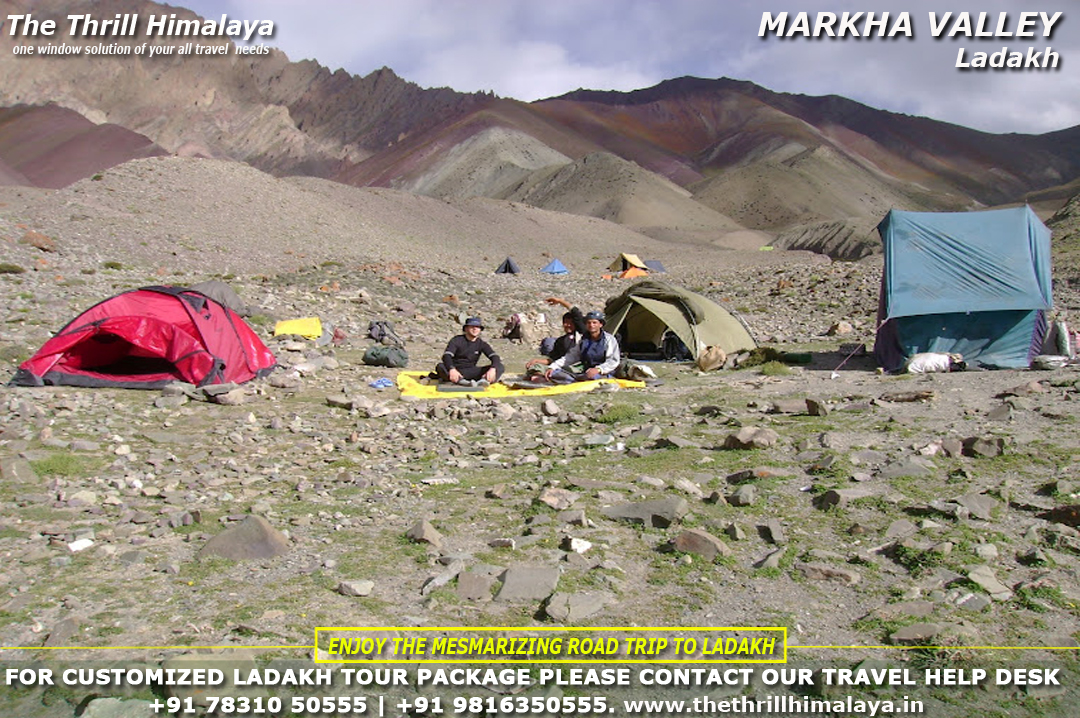
Markha Valley Camping: If camping is your thing then you won't find a better spot than at the Markha valley in Ladakh! You can trek up to some amazing sites such as Markha, Skiu and Hankar for starters. Once you reach the summit, you can unwind with some lovely tents, bonfire and make friends with strangers. Quite the deal, don't you think? There are two types of camping that one can enjoy immensely in Ladakh - leisure camping and adventure camping. Leisure camping can be relished at some of the most beautiful places in Ladakh like along the Pangong Tso, Tso Moriri; in the beautiful Hunder Village of Nubra Valley; and areas around Leh.
For more information please call us at: (+91) 78310-50555, (+91) 98163-50555

Trekking in Ladakh: Ladakh offers some wonderful and exciting trekking experiences to the visitors. This Himalayan region is a haven for those seeking adventure in the lap of mountains and peaks. There are many trekking options in Ladakh, which vary in difficulty and duration.
For more information please call us at: (+91) 78310-50555, (+91) 98163-50555

Shopping In Leh Ladakh: It is hard to go to a place and come back empty-handed to your folks waiting with wagging tongues for your exploits. You never disappoint them - that's rule number one to living a long life. What's harder still is to rip your eyes and heart off the pristine terrain and people, the spiritual, happy culture, vibes of freedom and the taste of bliss that are presented on a platter in Ladakh, without as much as bringing home souvenirs and memorabilia that will assist you down the path of retrospection. The pristine land lost in time has become increasingly tourist friendly. Credit it to the movie 3 Idiots if you must, but thank the soul-searchers, backpackers and tourists who explored the land before you did and created a vivacious market for 'tangible memories of Ladakh' to carry home with them. From pocket-friendly tokens to pieces of sartorial luxury, and adornments for home, there is much for everyone's taste while shopping Ladakh. Let's take a look at the zillion ways and places you can burn a hole in your pocket or come out unscathed from the shopping hysteria with your sharp bargaining skills!
For more information please call us at: (+91) 78310-50555, (+91) 98163-50555


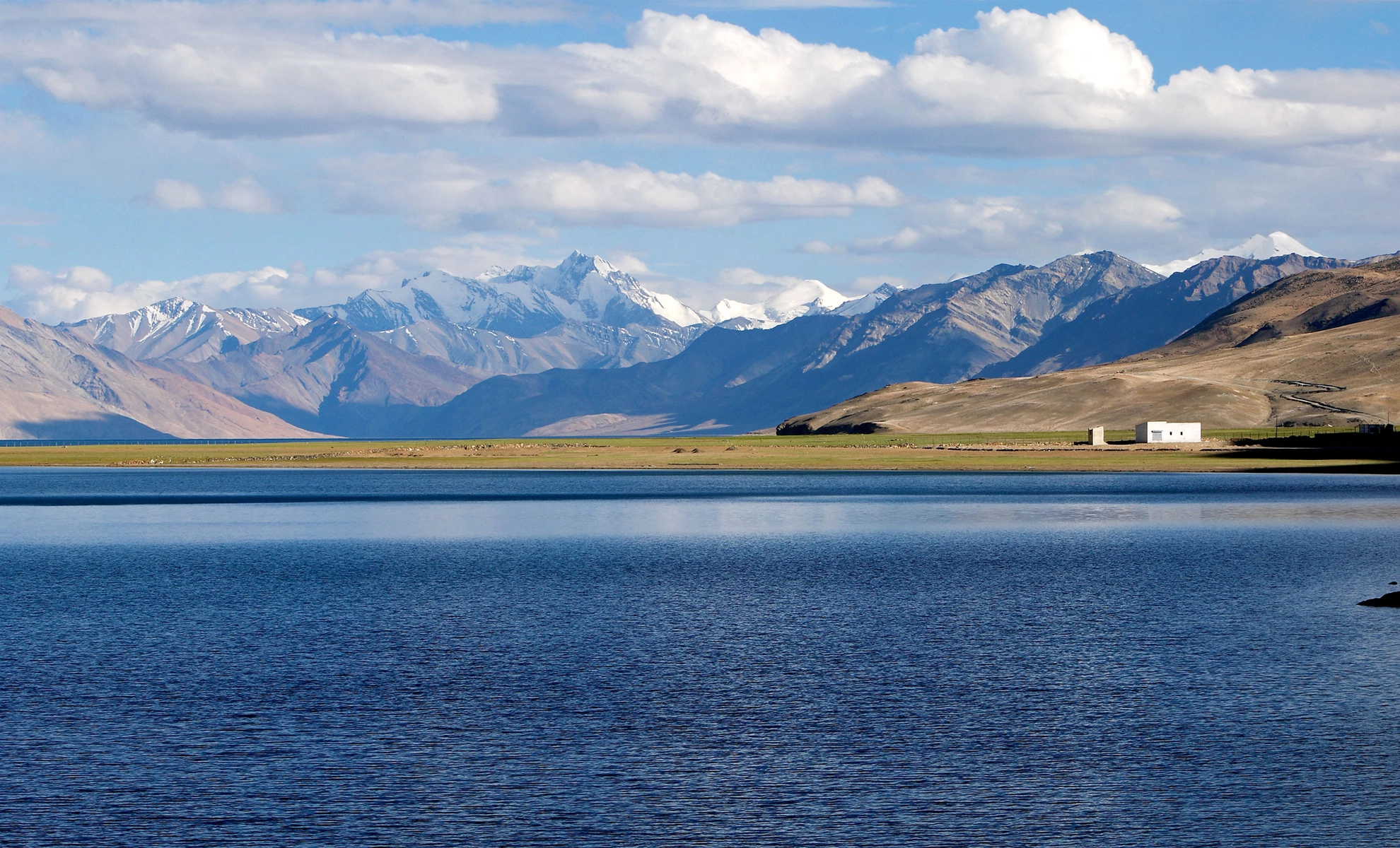
.webp)
